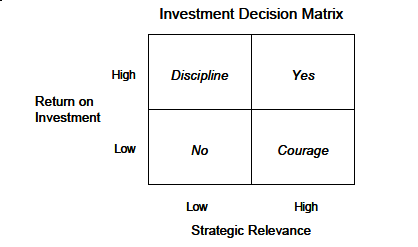Yesterday, I had a lengthy conversation with the Vice President of Finance of a major company. He was immersed in the capital budgeting process, and wanted to discuss ways to evaluate investment proposals.
Our conversation started with a discussion of the cost of capital, which is an important ingredient in evaluating investments. After all, what could be more logical than ranking investment opportunities by their projected returns, taking into account the cost of capital, and putting money into the most lucrative opportunities?
In my writing, I argue that all revenues are not equally desirable – some produce high profits, and some actually produce losses. Profitability management is all about figuring out which is which, and how to get more profits from an existing business.
But are all profits equally desirable?
The answer is no – and the key to understanding the difference between “good profits” and “bad profits” is the Investment Decision Matrix, pictured below.

The desirability of an investment is not just a function of the likely returns, but also and more importantly, the strategic relevance (whether the investment moves the company’s strategy forward).
Two quadrants of the matrix are easy, the other two take some thought. Let’s start with the easy ones. The upper right, high returns and high strategic relevance, is an obvious winner. The lower left, low returns and low strategic relevance, is a pretty poor bet.
Think about the upper left, high returns but low strategic relevance. This quadrant is quicksand. These investments look very attractive, but take the company’s capital and focus away from its main line of business. All too many companies have unclear and unproductive positioning because they lack the discipline to say no to attractive-looking investments that don’t fit. Ultimately, companies that do this get picked off by highly-focused competitors. These are the investments that produce “bad profits.”
Let’s look at the lower right, low returns but high strategic relevance. These are investments that would show up at the bottom of a simple capital budgeting ranking, but are essential to moving the company forward. Here, the watchword is “courage.”
For example, I remember meeting with the top officers of a major telecom company several years ago when telecom companies first began to develop video capabilities that could compete with cable TV. The company had a study that showed that an early investment in video would not pass the company’s investment hurdle rate. The question was whether to invest.
After discussion, the officers saw that the real question was not whether this initial video investment produced high enough returns. Rather the right question was whether the company was willing to remain the dominant communications channel into millions of customers, or whether it was willing to open the door for a host of competitors to get a foothold in all of their customers. Fortunately, the management team made the right decision.
The moral of the story: If investments in the upper left quadrant produce “bad profits,” investments in the lower right produce “good losses.”
How is this possible? Investments are virtually always part of larger business or strategic initiatives. The correct frame of analysis is the overall initiative, not just the component investment.
Within this strategic context, capital budgeting is a useful way to evaluate alternative ways to accomplish a strategic goal (e.g. which machine to choose), but you can’t use capital budgeting to determine strategy.
This is why it is so important that CFOs and other top finance managers be broad-gauge strategic thinkers, as well as disciplined business managers. Their company’s future depends on it.
